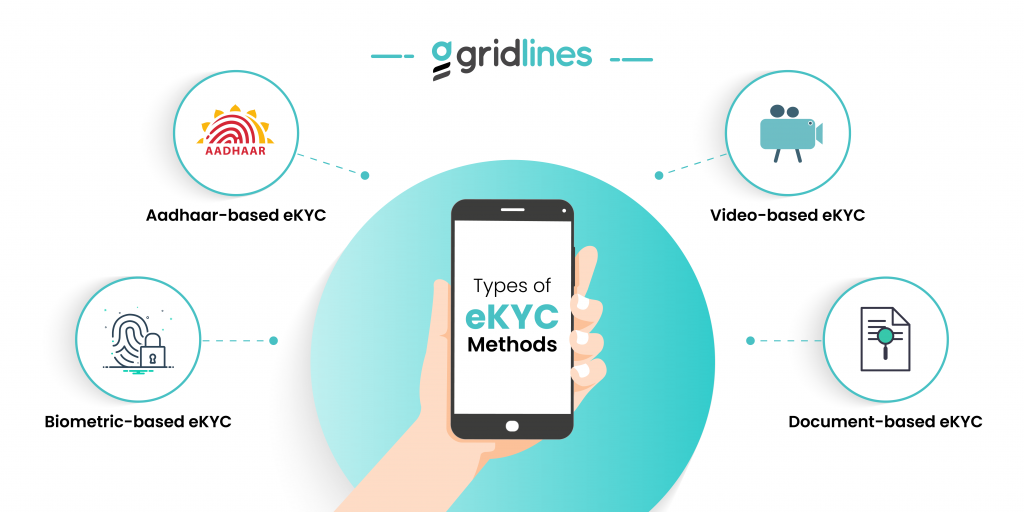Understanding eKYC
eKYC is the digitized version of the traditional ‘know your customer’ (KYC) process. The Reserve Bank of India (RBI) mandates financial institutions to carry out KYC for verifying and authenticating a customer’s personal data using government authorized OVDs(officially valid documents). With eKYC, authorized organizations and agents verify a customer’s identity and address digitally via national IDs like PAN, Driver License, Voter ID and Aadhaar.
Here are some key features of eKYC over traditional KYC methods:
- Faster and Simpler: It uses digital verification for quicker processing and easier onboarding.
- More Secure and Convenient: It prioritizes data security with digital measures and offers convenience with anytime, anywhere verification.
- Cost-Saving and Eco-Friendly: It brings significant operational efficiency, with verification time reduced from hours/days to seconds.
Also read : What Is Face Match in KYC and How Does It Work?
Electronic KYC: A solution to quick and secure customer identification and onboarding
Electronic Know Your Customer (eKYC) has emerged as a solution that streamlines the identification process while ensuring compliance with regulatory requirements. eKYC has revolutionized the way businesses verify identities.
eKYC leverages digital technology to verify customer identities remotely. This eliminates the need for physical documents and in-person meetings, making the process faster, more convenient, and secure for both businesses and customers.
In this blog post, we will dive into the meaning of eKYC and explore the various types of electronic KYC methods being utilized across different industries.
Why Is Electronic KYC Important?
The eKYC provision holds immense importance for several reasons:
- Enhanced Security: Customer identity verification is paramount. The government authorities like Protean, Unique Identification Authority of India (UIDAI) permits select organizations and agents to conduct eKYC services, ensuring that your information remains safe and isn’t misused.
- Improved Efficiency: It eliminates the need for manual data entry and physical document verification, saving time and resources for both businesses and customers.
- Hassle free User Experience: Customers can complete the verification process from anywhere, at any time, on their smartphones or computers, making it a smoother onboarding experience.
- Reduced Fraud: eKYC’s robust verification methods make it more difficult for fraudsters to impersonate legitimate users.
- Cost Savings: Businesses save money with reduced paperwork and faster onboarding processes.
Types of eKYC Methods:
There are various methods employed in eKYC, each offering different levels of security and verification –

Aadhaar-based eKYC
With Aadhaar-based electronic KYC, individuals can provide their Aadhaar number and consent for organizations to retrieve their information directly from the UIDAI system. Aadhaar-based electronic KYC is widely used in various sectors, including banking, insurance, and government services.
Video-based eKYC
It involves conducting a live video session between the customer and a representative of the organization. During the session, the customer’s identification documents are verified by comparing them with the live video feed. Video-based electronic KYC is commonly used in sectors like e-commerce, travel, and online marketplaces.
Document-based eKYC
Customers submit scanned copies of their ID and address proofs. The organization then verifies their authenticity with issuing authorities. This is a solid choice for sectors like banking, insurance, and e-commerce.
How Does Aadhaar eKYC Work?
- Aadhaar Number: To initiate electronic KYC, you need an Aadhaar number.
- Verification Modes:
- Aadhaar OTP: You will receive a one-time password (OTP) on your registered mobile number for verification.
- Biometric-Based: This method uses your biometric data (fingerprint or iris scan) for authentication.
- Data Flow: When you authorize your service provider, the UIDAI provides details such as your name, address, gender, date of birth, and more. The entire Electronic KYC process is seamless and cost efficient.
The Role of Gridlines’ Verification APIs in eKYC process
Gridlines verification APIs play a crucial role in enabling eKYC functionalities within various applications and platforms. Gridlines provide ease of integration of these verification APIs seamlessly into their existing workflows.
While it offers a variety of methods, verification APIs play a crucial role in simplifying and expediting the process. These APIs act as digital workhorses, automating key verification tasks:
- Aadhaar Verification API: With user consent, the API retrieves pre-verified information like name, address, date of birth, gender and more, eliminating the need for manual document collection.
- PAN Verification API: This API verifies a customer’s Permanent Account Number (PAN) against government databases. It confirms the PAN’s validity and can even retrieve basic identity details associated with it.
- Driving License Verification API: Similar to the PAN verification API, this API checks the authenticity of a driver’s license against official databases. It streamlines address verification and provides additional user information in some cases.
Know More: Gridlines Products APIs Suite
By utilizing these Verification APIs, you can:
- Automate KYC processes: Streamline onboarding and verification procedures.
- Ensure data security: Gridlines prioritizes data security and user privacy.
- Data Retrieval: APIs fetch relevant customer data from authoritative sources.
- Compliance: APIs ensure adherence to regulatory requirements.
Conclusion
eKYC is transforming the way businesses verify customer identities. By offering enhanced efficiency, improved user experience, and robust security, it benefits both businesses and customers. Coupled with the power of eKYC APIs, businesses can ensure a smooth and compliant onboarding experience while meeting the demands of the digital age.
FAQs
Q1. What is eKYC and how is it different from traditional KYC?
eKYC, or electronic Know Your Customer, is a digital method of verifying a customer’s identity using government-authorized documents. Unlike traditional KYC, it eliminates paperwork and physical presence, making the process faster and more secure.
Q2. Is eKYC mandatory for all financial services in India?
Yes, as per the Reserve Bank of India (RBI) guidelines, eKYC is mandatory for regulated financial institutions to verify customer identity before onboarding.
Q3. What documents are accepted for eKYC verification?
Accepted documents include Aadhaar, PAN, Driving Licence, Voter ID, and Passport, depending on the service provider and the type of verification.
Q4. How secure is the eKYC process?
eKYC is highly secure. It involves data encryption, consent-based sharing, and is often done through government-authorized channels like UIDAI or licensed verification APIs.
Q5. What are the benefits of using eKYC over manual KYC?
eKYC is quicker, reduces paperwork, lowers costs, minimizes human errors, enhances security, and allows remote verification from any location.





Leave a Reply